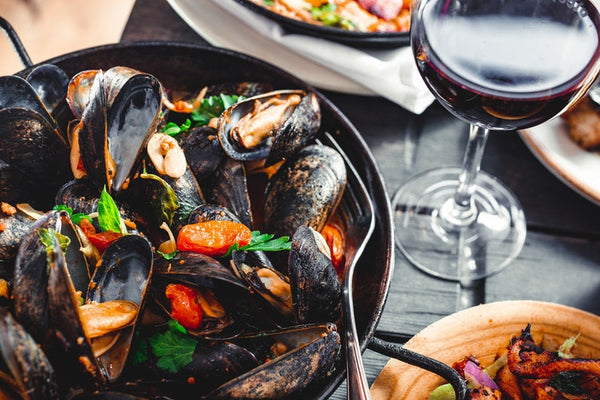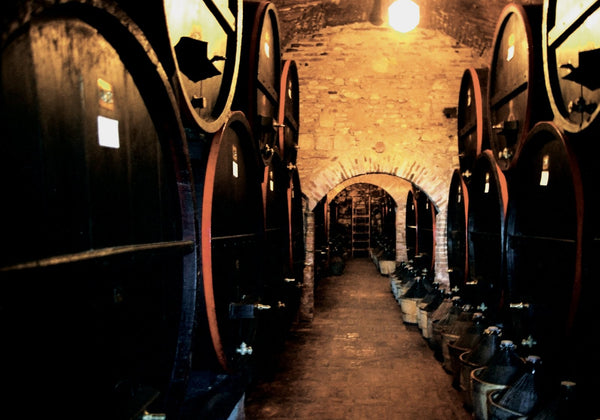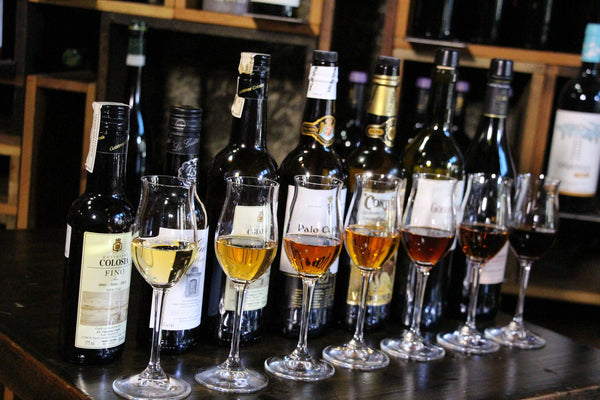
Top Spanish Food and Wine Pairings
If you've been keeping up with wine news over the last few years, you'll have seen a huge rise in the amount of writers now exploring beyond the great, famous regions of the world and we're all the richer for it. Spain is a country that's seen its layers slowly peeled back and its secrets increasingly revealed; there's a lot more to it than just Priorat, Cava and Rioja! With over 70 strictly defined appellations and as the 3rd largest producer of wine in the world, it doesn't come as much of a surprise to learn that we've probably missed quite a lot of the action, but we're slowly making amends!
However, what about the food as well? Spain has a rich culinary history and, not unlike its best, it seems to be being discovered and celebrated increasingly more and more! From Anthony Bourdain's adventures around Barcelona and San Sebastian to Michelin starred chefs spreading their wings and setting up operations in other parts of the world, it looks increasingly likely that we'll have opportunities to enjoy authentic Spanish food more and more!
After several trips to Spain in the last few years, we decided to bring the two together and talk a bit about traditional food and wine pairings, using the rich tapestry of the Spanish gastronomic scene as our guide. It's time to get started and, if you enjoy it, don't forget to read a similar guide we did for Portuguese Food and Wine Pairings!

Spanish Seafood and Wine Pairings
Spain is famous for its seafood and rightly so! With the Mediterranean to the east and the Atlantic to the west, there's a rich range of seafood dishes, many of which have a strong connection to local cultures. These seaside areas tend to be amongst the cooler regions in Spain, resulting in wines that have the acidity and delicacy to work together perfectly, bringing the dish to life in a beautiful combination of flavours and textures! Here are our 3 favourite Spanish seafood and wine pairings:
The Dish: El Pulpo a La Gallega
Galician octopus must surely be one of Spain's most famous dishes of all time, and its charm is in its rustic simplicity. Boiled, salted and sprinkled with paprika before serving on a rough wooden board, the distinct texture, saltiness and subtle paprika spice is a wonderful combination, particularly when served with fresh bread to mop up the juices!

The Wine: Godello
Godello is one of Galicia's most interesting white grape varieties, usually found further inland on the steep, granitic slopes of DO Valdeorras. It's high, broad acidity and clean mineral flavour is the perfect foil to the substantial texture and subtle flavours of the octopus, and the freshness of the wine means it'll stand up to any citric components that might be served alongside! Rafael Palacios is the architect of the regions greatest Godello, but do keep an eye out for Valdesil and Avanthia, too!

The Dish: Seafood Paella
Paella is a very misunderstood dish and has become an unwilling flagbearer for sea-food, far beyond its original creators in Valencia. Originally created as a peasants dish of rice with various meats, snails and vegetables, paella arguably works better as a seafood dish, bringing a savoury richness to delicate morsels like mussels, clams and langoustines. Psst! If there isn't saffron in it, it isn't paella!
The Wine: Albariño
We're going against the adage of 'What grows together goes together' here by heading across to the other side of the country, to Galicia, where the Atlantic-swept coast of DO Rias Baixas produces Spains most iconic white grape; Albariño. This zesty, aromatic white wine is the perfect foil for paella: fresh enough to add a little zip to proceedings yet subtle enough to not overwhelm any flavours. Some of the more ambitious producers like Bodega Fulcro, Eulogio Pomares and Finca Leirana would be perfect, if you can find them!
The Dish: Bacalao a Pil-Pil
A traditional dish from the Basque country in northern Spain, renowned for their fresh cod fishing for hundreds of years! Again, sometimes it's the simplest dishes that stick with us for the longest time and this combination of flakey white fish, garlic and olive oil is just that. A continuous motion whilst cooking stops the fish from drying out whilst infusing the fish with all the flavours of the sauce, which can be thickened according to taste. An ideal aperitif or, if served with vegetables and rice, a great main course for the cooler months!

The Wine: Txakoli
Txakoli is a spritzy, light white wine from the Basque country and is mostly served as an aperitif. Whilst more ambitious bottlings exist, the majority are low in alcohol, very high in acid and full of the cool, green fruited flavours of a region abutting the Atlantic ocean. The zesty acidity is key to working with Bacalao a Pil-Pil, which freshens the dish whilst the delicate flavours will allow the savoury garlic, salt and oil to shine through. A glass of this with a small portion of Bacalao to start an evening? Count us in!

Spanish Meat Dishes and Wine Pairings
Spain, not unlike Portugal, isn't a particularly easy country for vegetarians. The cooler, 'greener' regions of Spain are famous for their quality beef, whilst further inland lamb and pork rule the roost. We once heard a tour guide tell us the Spanish pork is 'How pork is meant to taste' and after sampling a few choice dishes, we're hard pressed to find reasons to disagree! Better yet, as Spain is predominantly a warm country, there's plenty of red wine in different styles to go around, ideal for our food and wine pairings!
The Dish: Slow Roasted Lamb
In the north of Spain, particularly around Rioja and Navarra, lamb is the order of the day. In the land of earthy, savoury red wine, a thyme-infused shoulder of lamb, coated with gravy and served alongside roast vegetables is about as good as it gets. In the best restaurants, this lamb is often encased in a clay vessel and allowed to gently cook throughout an entire day, becoming more tender and flavourful with every passing hour. The shoulder joint is a common option and it should fall apart by the end of the process!

The Wine: Mature Rioja
Rioja is the most famous wine region in Spain and mostly comes into the form of a Tempranillo dominant blend, often with Garnacha and Carignan playing a supporting role. The traditional bodegas of La Rioja Alta, Muga and Lopez de Heredia are an ideal pairing for a slow roasted lamb dish, particularly with a little bottle age; not difficult as the most recent vintages for most of these wines is around 2010! The savoury, tobacco-inflected red fruits, moderate alcohol levels and refreshing acidity fits perfectly with the gamey flavour of the lamb, bringing out the best in both without either taking centre stage. One of Spain's truly great wine pairing classics!

The Dish: Jamon Iberico de Bellota
Jamon is one of Spain's most famous products, and the meat that comes from Iberian pigs is at the very top of the quality pyramid. Smaller, more muscular and layered with intracellular fat, there's a reason why this jamon is considerably more expensive than Serrano or Jamon del Pais. Ideally carved wafer-thin, to the point where room temperature makes it almost translucent, this is a luxurious dish that can only be improved by serving it atop of crispy pan con tomate. We're salivating!
The Wine: Brut Nature Cava
Whilst most meat dishes tend to pair better with red wines, the incredible delicacy of Jamon Iberico de Bellota demands something a little gentler, and Cava is absolutely ideal for this. Generally drier than Champagne due to the greater fruit richness and lower acidity, the earthy, appley flavours of Xarel.lo and the refreshing mousse of the bubbles melts together with the richness and the fat of the jamon to create a complete, dining experience. A big plate of jamon (not cheap!) and a bottle of Cava is about the best lunch we can think of in Spain! Look for Recaredo and Gramona for the ultimate expression of what Cava can be.
The Dish: Secreto de Iberico
Two pork dishes, and it comes as no surprise; this is the meat that Spain is most famous for, after all! Secreto de Iberico is something quite special though; a small cut of meat from just behind the shoulder of the pig, with a remarkable combination of both juicy flavours and a relatively lean profile. It's best when cooked rapidly under a grill, giving the thin layer of fat on the outside a crispy, crunchy texture whilst preserving the incredibly tender flavours within. Stunning with nothing more than salt-sea to garnish.

The Wine: Sierra Gredos Garnacha
Garnacha, better known in the rest of the world as Grenache, is one of Spain's greatest vinous treasures; birthed in Aragon and at home practically everywhere in the country. One of its most remarkable expressions, however, is in the elevated climates of the Sierra Gredos mountains, a line of rugged, granitic slopes to the south of Madrid. Old bush vines are tended by the likes of Bodega Maranones and Jimenez-Landi, producing pale-coloured wines full of vibrant red fruits, sappy herbs and cool, mineral influences.

Spanish Dessert and Wine Pairing Dishes
Dessert isn't as important in Spain as it is in many neighbouring countries, yet there are one or two culturally important, delicious dishes that we can't help but get excited about. Fortunately, wine production in Spain is vast and diverse enough to cover practically every eventuality, so there's never an issue finding the right pairing!

The Dish: :La Crema Catalana
With Catalunya positioned so close to the border with France and a history that sees the old kingdom of Aragon stretching far into modern-day Languedoc, it comes as no surprise to see some gastronomic references to both. However, La Crema Catalana is one of the few dishes so good that the French saw fit to copy it, creating their Creme Brulee off the back of this 14th century recipe. A light, fluffy egg custard is produced with a combination of milk, cream and lemon zest for addition zip, whilst the sugar and cinnamon layer on top is caramelised with a blow torch, with all the fun of breaking into this treasure that it entails!
The Wine: Fortified Emporda Whites
Now, this is something a little specific but well worth hunting down if you get the chance. In the north of Catalunya, the region of Emporda is more similar to the south of France than anywhere else in Spain, including the incredibly old Solera Systems that allow their sweet wines to undergo long, oxidative ageing. The result is a strong, sweet wine full of nutty, caramelised flavours and hints of bruised fruits that work wonderfully well with the tangy, slightly burnt flavours of La Crema Catalana. A very Catalan way to finish a meal!
The Dish: Torrija
The Spanish equivalent of French Toast; much like France, the story goes that this dish was created using the excess egg yolks from wine-making processes and turned into something delicious! Stale brioche bread is soaked in sweetened milk and eggs, then fried in olive oil and dusted with cinnamon sugar. The end result is to die for, with a crispy outside and fluffy inside. They are sometimes even soaked in wine instead of milk, or drizzled with honey for an extra punch of flavor.

The Wine: Oloroso Sherry
Sherry from the south of Spain is one of the worlds great, often unappreciated treasures and some of our favourites are the oxidised, rich Oloroso styles that spend a great many years ageing in Solera Systems in Jerez herself. The nutty, high-toned flavours are a delight in themselves but work even better with a textural foil, and the sweeter flavours of Torrija brings out some of the more delicate nuances in even the most aged, noble Oloroso! Look for the wines of Valdespino and Lustau.
We could go on and on about the delights of Spain's food and wine scene, but we wouldn't want to spoil all the discoveries along the way! With thousands of years of history and experience in both, as well as with 70 distinct wine regions, needless to say there's a lot of gems we haven't discovered either! Regardless of whether you're in the baking south, the cooler north or around the major cities of Spain, there's always a reason to show up hungry. For more information on the Spanish wine scene, why not check out some of the guides we've written for Madrid, Barcelona, Seville and Rioja? Salud!
For more on our specially designed wine luggage and more detailed information on how to travel with alcohol, check out the links below:






Leave a comment
This site is protected by hCaptcha and the hCaptcha Privacy Policy and Terms of Service apply.